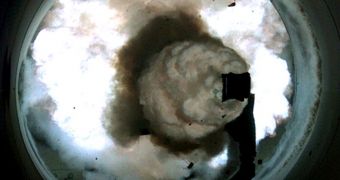At this point, railguns are among the most devastating long-range weapons that can be deployed to the battlefield. Experts at the US Navy Office of Naval Research (ONR) want to make them even more effective, by having them fire in rapid succession.
The thing about railguns is that they use electromagnetic forces to accelerate projectiles, rather than the explosives normal rounds do. An object is placed between two conducting rails, through which a high-intensity current is rapidly circulated.
This causes the object to be ejected at tremendous speeds, depending on how much electricity is delivered. The most powerful railgun in the world – which was also built by the ONR – can fire so fast that its projectile incinerates the atmosphere; literally sets it on fire (see video below).
One of the obstacles preventing the conversion of a railgun into a fast-firing weapon is the fact that large amounts of electricity need to be stored in supercapacitors before each shot. This takes time, and also limits the weapon's firing rate.
By developing a system capable of delivering pulsed power to the railgun, ONR investigators hope to convert the weapon into an asset capable of destroying an entire swarm of incoming missiles all by itself. Due to its range, the railgun could also be used in naval battles.
Given their bulk, railguns are usually mounted on ships. Such vessels could engage the enemy from a great distance, far beyond their line of sight, and still hit with extreme accuracy. Alternatively, the railgun rounds could be used to destroy shoreline fortifications or bunkers.
ONR experts say that they want to increase the railguns' firing rates from 6-10 per minute to hundreds of shots. More precisely, the Office wants to be able to fire rapid bursts of hundreds of shots each, in rapid succession.
A railgun has devastating range. It can hit targets located hundreds of miles away from its current position. Its projectiles travel at speeds between 4,500 and 5,600 miles (7,242 and 9,012 kilometers) per hour.
“The next phase of the development effort is to demonstrate the ability to operate at a firing rate of significant military utility,” ONR Electromagnetic Railgun Program Manager Roger Ellis says.
The Office has already awarded Raytheon Corp., BAE Systems and General Atomics with three $10-million contracts, for the development of a pulse power system capable of sustaining the rate of fire the Navy is interested in.
In the future, the United States may have access to railguns capable of firing 32/33-megajoule shots at distances up to 220 nautical miles away, Innovation News Daily reports.

 14 DAY TRIAL //
14 DAY TRIAL // 